Michael Clark and Nicolas Roeg at Janus the home of Drawing Breath October 2002
Limited edition photograph. Printed & editioned with the support of AGFA UK Ltd.
12 1/2” x 9 3/4” Artist’s Proof
(Formally in the collection of Stephen Wheatley)
Collection TATE ARCHIVE © 2002 Michael Clark
Friday 16th November 2007
|
Located on the threshold of 40 Old Compton Street, Soho, London, Drawing Breath takes place annually throughout November at 9.30pm each evening, Monday to Saturday, 6.30pm on Sundays with matineés at 2.00pm on Saturdays, Sundays. Tuesdays and Thursdays. The duration of the work is approximately 29 minutes. However, please note that the structure of this work incorporates units of up to eight minutes of silence. |
Limited edition Artist's Book designed by Steve Wheatley with text by Geoffrey Macnab
Collection TATE ARCHIVE © 2002 Blessé
"Michael is extraordinary in the way he marries emotion, sound and painting. It (his work) is a combination of all the senses... why should art attack only one sense at a time?" (Nic Roeg on Michael Clark.)
130 years ago on the 1st November 1872 Arthur Rimbaud the precocious French poet maudit attended a lecture given at a refugee club above a public house in Old Compton Street, Soho. To mark the anniversary of Rimbaud's presence in Old Compton Street, Michael Clark has created Drawing Breath - a minimal symphony of inhalations, echoes, vowels and silence.
Clark's last major work, 10: 07-09, was displayed over Holy Week in Winchester Cathedral. That's a long way removed from the home of Drawing Breath; the black varnished doorway of Janus, one of the first licensed sex shops in Soho.
Clark sees no incongruity in the transition from cathedral to sex shop. Using Janus, he argues, is not some prurient stunt, but the most appropriate way of paying tribute to Rimbaud. At a time when much of what was once deemed pornographic is finding a home within the bastions of high culture (a Museum Of Sex has just been opened in New York), he argues that he is moving in the opposite direction, taking work out of the rarefied confines of the gallery and into the illicit space of the sex shop.
As Rimbaud confessed in A Season In Hell, he steeped himself in squalor and degradation and tried to "derange all his senses" in a bid to write a new kind of transcendent verse. He had an almost religious devotion to corruption. Drawing Breath (which derives its structure from a 13th Century Italian mathematical sequence and early sonnet form) follows the esoteric coding of his famous vowel poem, in which he attempted a "synaesthesia of language", with each vowel assigned an alchemical significance. Beginning with A (black) and ending with O (blue). The symbolism also has a religious dimension, explicitly referring to the Alpha and Omega of Christ. Clark has enlisted Nic Roeg (subject of one of his best known portraits, Al-Jebr commissioned by the National Portrait Gallery) to intone the vowels that feature in Drawing Breath.
Clark sees his goal as similar to the one set by Georges Bataille when he wrote: "my purpose is to illustrate a fundamental connection between religious ecstasy and eroticism - and in particular sadism". The title is partly intended as a reference to My Last Breath, the memoir of surrealist filmmaker, Luis Bunuel, who shared Clark's interest in religion and flagellation. In Rimbaud's.work, too, sexual and religious ecstasy, inspiration and sado-masochism, were often intertwined. (it's intriguing to note that when Rimbaud was in London, he visited the British Library in an attempt to read the works of De Sade, but much to his chagrin, was denied access to such inflammatory works.) Graham Robb's biography of the poet recalls that a contemporary critic, trying to unravel Rimbaud's verse, "had a vision of Rimbaud's vowels as graphic representations of a woman's body in orgasm".
Soho has always drawn taboo-breaking filmmakers and artists. Francis Bacon and filmmaker Derek Jarman (both painted and drawn by Clark) were often to be seen on Old Compton Street. Among the first places that Pier Paolo Pasolini's long-banned Salo, or the 120 Days Of Sodom was shown in the UK was in a private member's cinema on Old Compton Street. A sequence in Nic Roeg's and Donald Cammell's Performance, was set in a Maltese sex cinema close to Janus.
As Clark points out, Janus was the Roman God of the "door", and the door has been a key symbol in his work. l0: 07-09, was projected onto the Great West Door of Winchester Cathedral and took as its inspiration, these lines from St John: "l am the door: by me if any man enter in, he shall be saved". Clark's other, overlapping obsession is the motif of the wound. "The borders of a wound are lips. Therefore, at some stage, the wound may speak. That's an idea that comes through Bunuel and Cocteau", he notes. Again, the sexual and religious connotations are obvious. Clark cites Richard Crashaw's lines: "O these wakefull wounds of thine! Are they Mouthes? or are they eyes?"
There's an old tradition that newborn babies used to be slapped to jolt them into breathing. That's perhaps where the age-old fascination with flagellation - which Janus caters to - is rooted. ("Don't want you to thank me. Just want you to spank me", Madonna sang in Hanky Panky.) At bottom, for all its many references, Clark's piece is dealing with something both simple and primal. As he notes, drawing breath is "the first thing we do and probably the last".
Geoffrey Macnab, October 2002
Michael Clark, Drawing Breath - An essay by Charles Darwent
Each November for the past four years, Michael Clark has installed an artwork called Drawing Breath in the doorway of Janus, a Soho sex shop known for its line in sado-masochist erotica. This November, Drawing Breath will put in its fifth appearance there. Although Clark describes the piece as a sculpture, you won’t see it if you visit 40 Old Compton Street. This is because Drawing Breath is a site-specific sound sculpture, which is to say one made with a particular place in mind and using sound (rather than, say, bronze or marble) as its material.
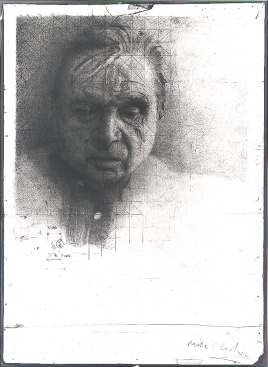 You may not see Clark’s artwork as you walk down Old Compton Street, in other words, but you will certainly hear it, at least if you are there between 9.30 and 10pm, which is when it is played. (On Sundays, the piece runs at 6.30pm; there are 2pm matinées on Tuesdays, Thursdays and at week ends.) Roughly, Drawing Breath consists of a series of moans and breaths. Depending on when you pass by, the moans may be Ooooooo…ooooo…ooo or Aaa…aa…a…a. These were recorded by the veteran film-maker, Nicolas Roeg – director of such classics as Bad Timing and The Man Who Fell to Earth – and are played through hidden speakers. Hearing moaning and heavy breathing from the doorway of an S&M shop may make you feel various things: disturbed, amused, turned on. Drawing Breath is meant to elicit all those reactions, and more besides. But first, let us talk about sound sculpture. Unless you’ve recently graduated from art school, the phrase may seem like a contradiction in terms. Sculpture may be cast or carved or made of found objects, but it must be solid.
Or must it? In 1969, the American artist, Michael Heizer carved a 50-foot-deep, 750-foot-long nick in the side of a valley in Nevada; then, across the way, he carved another, matching nick. Making these two trenches called for the removal of a quarter of a million tons of rock. The result, as you’d expect, is monumental but it’s also sculptural – an artwork that looks like it might have been made by Mayans or Egyptians. Yet Double Negative is a void, an absence, something made of nothing.
All sculpture is like this. If Michelangelo hadn’t chipped away at marble, there’d be no David: what is missing is as important as what is there. And Michael Clark’s sound sculpture is also about what isn’t present, about the power of things lost. Sound can not travel through a vacuum. To exist, it has to come from somewhere, go somewhere, to encounter something – you – on its way. Sound sculpture is less empty than it seems.
But why a and o? Among many other things, Drawing Breath is meant as a homage to the French poet, Arthur Rimbaud. Rimbaud and his lover, Paul Verlaine, lived in Soho in November 1872, escaping the latter’s wife and the threat of prosecution. Rimbaud, just 18, had already shaken French poetry to the core. The previous year – 1871, the year of the Paris Commune – he had written a sonnet called Voyelles in which he proposed that every vowel signified not simply a sound but a colour: A noir, E blanc, I rouge, U vert, O bleu. When Roeg moans ooo and aaa, he is thus also intoning the colours black and blue; again apt, given Janus’s speciality in S&M.
What you may by now be gathering is that there is a great deal more to Drawing Breath than meets the ear. Contained in Roeg’s apparently inchoate moaning is a vast frame of reference: to poetry and mathematics and, beyond these again, to levels of hidden meaning which replicate themselves exponentially like Fibonacci’s numbers.
Among these references are many to Michael Clark’s own life and work, Roeg being one. In 1999, Clark was commissioned to make a portrait of the director for the National Portrait Gallery. The resulting piece, in the NPG’s collection, shows all the hallmarks of Clark’s taste for unlikely connections. It is a fascination he shares with his subject: sitting in Maison Bertaud, a tea-shop around the corner from Janus, Clark points out that Roeg’s movies are themselves famously fragmentory, swapping lenses, gauge, viewpoint and from colour to black-and-white. “I’d had him in my sights for 18 years,” he laughs. “Not least because Roeg is an anagram of “gore”.
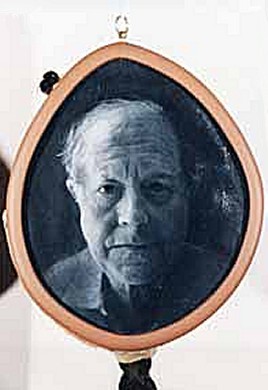 Another connection came via Francis Bacon, Clark’s friend and mentor. Bacon was a fan of both the Janus sex shop and the films of Nicolas Roeg. He and the shop’s proprietor had been friends since the early 1970s, drinking at Muriel Belcher’s Colony Room. When Janus applied for a business permit from Westminster Council – it was Soho’s first licenced sex shop – Bacon wrote a letter of support. When Janus’s owner decided to paint his front window black, it was Bacon who did the painting. Clark recalls Bacon announcing in the Colony one evening that he had just seen "a wonderful film", it being Roeg’s Bad Timing. Around this time, Clark had begun to work on a series of portraits in various media of Francis Bacon. One of these, in graphite, is now in the British Museum. Apparently a traditional representation of Bacon, Clark’s portrait is unusual in retaining the diagonal grid on which it is composed. Lit from above in a Bacon-like way – you seem to see a naked lightbulb hanging overhead – the portrait plays a disturbing visual game by reminding us that it’s a fiction: that, for all its obvious skill and representational truth-to-life, it is a drawing of Francis Bacon, not Francis Bacon.
Given Bacon’s own remorseless insistence on the truth, this seems only apt. So, too, does Clark’s portrait of Nicolas Roeg. Roeg’s films are built up out of apparently dissimilar fragments, and Clark’s portrait of Roeg is built up of fragments of Roeg’s films. First, the portrait elides two dimensions with three: it consists of a painted depiction of the director, framed in what looks like the top of a skull or, perhaps, of the shaved head from Performance. Like Roeg, Clark cuts from colour to black-and-white, the portrait being in photographic-looking grisaille, the skull-frame in flesh-coloured wax. Another quality shared by the picture and its subject’s films is that both move. Suspended from a hook, Roeg’s portrait spins gently on its axis.
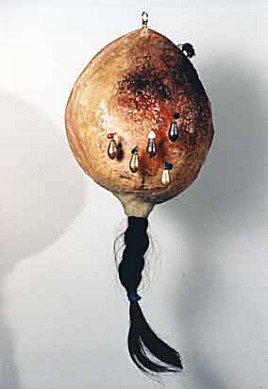 And then there are the direct allusions to his films. The drops of lead that hang from Roeg’s portrait become progressively more gilded, an echo of his film, Eureka, the tale of a modern Midas. The drops are fastened to the cranium with hypodermics coloured in the sequence that occurs in the alchemical process of turning base metals to gold: black, white, red, green, blue. These act as a visual counterpoint to Roeg’s grisaille portrait, but they are also the five colours of the opening line of Rimbaud’s Voyelles. It seems likely that the poet had been studying alchemy when he wrote his sonnet: certainly, one Rimbaud fan – the Russian director, Sergei Eisenstein – believed he had. Roeg was heavily influenced by Eisenstein as, of course, was Francis Bacon. And Bacon, as we’ve seen, was a champion of Janus and the tastes for which it caters.
By now it’s possible that your head, like Roeg’s, may be gently spinning. Stay calm: it’s meant to. One reason that Michael Clark is so fascinated by Rimbaud is the poet’s belief in an alchemical connection between things; sound and colour, pain and pleasure, gold and lead. You don’t have to know all the facts to sense these connections; on the contrary, their miraculousness lies in their mystery. Understanding that there are things you will never understand is part of what Clark’s work has always been about. Far from providing clues to be solved as a conceptual crossword, Clark keeps his knowledge to himself. When he had finished Roeg’s portrait, both men wrote secrets on strips of paper and hid them inside it. Laughing, Clark recalls that an NPG conservator asked him to disclose what they had written. "I had to point out," says Clark, "that if I told him, they wouldn’t be secrets."
Like Michael Heizer’s desert void, in other words, Drawing Breath is as much about withholding as it is about providing. The question of how we read a thing that isn’t there is central to both works, but it is also at the heart of Christian belief. Miracles, moments of revelation, only serve to point out the mass of things unrevealed. The point of Drawing Breath is precisely that we can not see the connective leaps between its various parts, nor between it and the rest of Clark’s work.
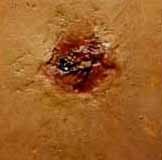 One of the more spectacular of those leaps takes us from Drawing Breath to the West door of Winchester Cathedral. If you were trying to define the poles of God and Mammon, then a cathedral and a sex shop would serve pretty well. And yet Clark has installed work in both places, and those works are profoundly linked. "My aim is to illustrate a fundamental connection between religious ecstasy and eroticism – and in particular sadism," he says, quoting Georges Bataille. "As one of Rimbaud’s critics said, his vowels were graphic representations of a woman’s body in orgasm".
As Clark speaks, I find myself thinking of 16th century German paintings of Christ as The Man of Sorrows, of the loving detail lavished on broken bones, the marks of the lash, His wounds: those five holes in the body that the poet, Richard Crashaw, saw as entries for sanctity. (The day after I meet him, Clark pushes a photocopy of Crashaw’s poem I am the Doore through my own door. It seems oddly apt.) Clark’s mentor, Francis Bacon, was also fascinated by the transcendant quality of pain, telling the younger artist that "Violence [could] unlock all kinds of areas of feeling and possibility."
Seen like this, the connection between cathedrals and sex shops is clear. Janus was the Roman god of doors, a two-faced deity able to see our comings in and our goings out. At Easter 2002, Clark played on this duality in 10: 07-09, an installation piece which projected images of his paintings of Christ’s wounds in Chichester Cathedral onto Winchester’s West door. Next to these, Clark shone Crashaw’s lines ("Now you lie open. A heavy spear has thrown back the bolt of your heart"), both projections changing colour in the order suggested by Rimbaud – A black, E white, I red O blue – as Roeg’s recorded voice intoned the corresponding vowels.
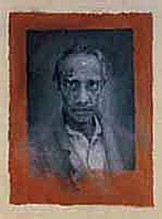 It may strike you by now that Clark’s work is unnecessarily complex, which is true and not. To be precise, Clark’s work is necessarily complex, complexity being both its material and its meaning. The bringing together of disparate media in a single Gesamptkunstwerk – poetry, painting, sound, photography – is intended to challenge. The mind likes categories; faced with work that steadfastly refuses to be categorised, it loses its way. You might call that loss all kinds of things: pain, trance, ecstasy, divine revelation. Any and all of them would be equally valid.
I’ve said that loss is at the heart of Michael Clark’s work, and nowhere is this more so than in his portrait of the film-maker and artist, Derek Jarman. Painted months before Jarman’s death from AIDS in 1994, Clark’s picture is as of a man already dead. Done, like Roeg’s portrait, en grisaille, the image embodies its own making. It is the painting of a photograph of a man: with each remove, Jarman slips further away. Clark has set the portrait in a surround the colour of dried blood, in part to play on the cinematic resonances of colour versus black-and-white but also to suggest Jarman as a modern Man of Sorrows. Sitting in the tea-room where the film-maker sat for him, Clark recalls how Jarman had scratched his ravaged face so hard that he had drawn blood. The artist included a smudge of his own blood in another Jarman portrait, called The Gardener, now in the Whitworth Art Gallery.
It is a useful way of thinking about Clark’s work, as a thing that is both itself and a representation of itself. A dozen years after Jarman’s death, the man who painted his portrait stops for a moment, then recalls the film-maker discussing a project he was working on at the time, a monochromatic work that would reflect his own fading eyesight. "In the end it was called Blue, though at the time Derek said that he was going to call it Blue Movie," Clark laughs. "That also ties in with Janus and Drawing Breath, when you think about it."
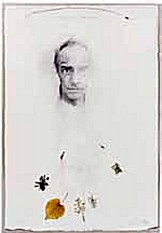 Names are slippery things, and nowhere more slippery than when it comes to naming Michael Clark’s work. The title of Drawing Breath may play on Clark’s own background as an artist – he draws with extraordinary facility – or on the first breath taken by a newborn child, brought on (aptly enough) by a slap. The vowels a and o, are also the Greek letters alpha and omega. By declaiming them, Roeg isn’t just invoking bruises: he is also calling up the Christian symbols for the beginning and the end, the Janus-faced process of living and dying. Drawing Breath may be a homage to the dead – to Rimbaud, Bacon,
Jarman, those ghostly absences from Old Compton Street – but, in its fifth year, it also suggests rebirth, a seasonal return. Beyond this, there is the question of what name to give to Clark’s kind of work. "Site-specific sound sculpture" may tie it down for a moment, but Drawing Breath is just one scene in a far larger drama. Clark is intrigued by the idea that Artaud disliked the phrase Theatre of Cruelty, although he was allegedly its inventor. A huge influence on both Roeg and Bacon, Artaud preferred the term "Theatre of Alchemy". It strikes me that another name, coined by Yves Klein, might usefully describe Clark’s art. Describing his own work, Klein suggested Theatre du Vide, the Theatre of Emptiness. Like Heizer’s void in the desert, Drawing Breath is concerned with the gap between alpha and omega, the first breath and the last; the ultimate secret.
Charles Darwent © 2006 Blessé
“Drawing Breath follows the hermetic coding of Rimbaud’s famous vowel poem in which he attempted a “synaesthesia of language”, with each letter and word assigned an alchemical significance.
To intone the vowels, Clark has recruited film-maker Nicolas Roeg, another figure who has an obvious affinity with Rimbaud. His films – including Performance, Eureka, Bad Timing and The Man Who Fell to Earth – touch on many of the same themes as Rimbaud’s best-known verse: sex, grief, nostalgia and estrangement.
Standing outside a Soho S&M parlour listening to a recording of sighs, groans and whispers doesn’t seem like the most obvious way to pay tribute to Rimbaud. But Clark insists that Drawing Breath is not some surrealist, Duchamp-style prank. Explaining the piece, he solemnly quotes Georges Bataille: “My purpose is to illustrate a fundamental connection between religious ecstasy and eroticism – and in particular sadism.” He also points out that one critic claimed that Rimbaud’s vowels stood as “graphic representations of a woman’s body in orgasm” – hence the decision to mount the piece in Janus.
Given the sadomasochistic nature of his relationship with Verlaine and his delight in shocking the bourgeoisie, Rimbaud would surely have appreciated the “homage” in a sex shop. What passers-by make of it is, of course, quite another matter”.
Extract from Loose Vowels Geoffrey Macnab finds Rimbaud’s legacy in Soho. © Guardian December 2002.
“Sound art responds to two contrary tractions in the practices of making and displaying art. One is the desire to burst boundaries, to tear down the walls, to break out of the confined space of the gallery. Sound is ideal for this because of its well-known expansiveness and leakiness.……Between 1st November and 14th December 2002, Michael Clark set up a sound-sculpture entitled Drawing Breath, consisting of a loop of panting sounds outside the Janus sex-shop in Soho. Since the shop specialised in the arcane of spanking, the reference was perhaps to the folkloric link between the midwife’s slap and the breath of life”.
Extract from Ears Have Walls: On Hearing Art, Professor Steve Connor, a talk given in the series Bodily Knowledges: Challenging Ocularcentricity at Tate Modern, 21 February 2003.
“Leaving my glass of absinthe on the bar I headed back into Old Compton street. This time I made my way to S & M shop Janus at number 40 where a strange tribute to Verlaine and Rimbaud had been installed. Michael Clark’s sound sculpture Drawing Breath. Verlaine and Rimbaud who so delighted in shocking the bourgeoisie could hardly have hoped for a more fitting tribute”.
Muriel Zagha presenter Prisoners of Albion produced by Sarah Jane Hall. Broadcast 19.03.04 BBC Radio 4.
“As Diary stood in the doorway of Janus, one of the most startling things was the reaction of the public, who looked concerned and intrigued by the guttural and nasal intonations emerging ...”
West End Extra 19th November 2004
Bacon’s influence threads through his works, reappearing even in his conceptual pieces. Be it in the appearance of wounds in his paintings, or in the location of a ‘ sound sculpture’ outside a sex shop that Bacon used to frequent (only in part to cash his cheques), his ghostly spectre appears again and again, if only obliquely, in his figurative and conceptual works. For Clark is not a portraitist, although he has created many portraits of people ranging from film directors to the characters of Soho of yesteryear to Royalty to Pop royalty. He is a conceptual artist, for whom the painstakingly accurate depiction of the human face is only one of his or media, and conversation with him ranges from the diverse influences of Rimbaud and Nauman as well as Holbein and Rembrandt.
Extract from Christie’s catalogue, The Collection of The Late Miss Valerie Beston - Artists from The London School – 8th and 10th February 2006 © Christie’s
“It is 134 years since Rimbaud and Verlaine, fleeing the suppression of the Paris Commune, walked these streets in search of a gin that didn’t taste (in their words) like “concentrated sewage”. Drawing Breath is a homage to Rimbaud, arguably the only poet who would have welcomed being immortalised in a sound installation in a sex shop.”
Extract from, “Take a deep breath … say ‘aaaaaaaaaaaaa’, Charles Darwent, The Independent on Sunday 29/10/06 © The Independent on Sunday |